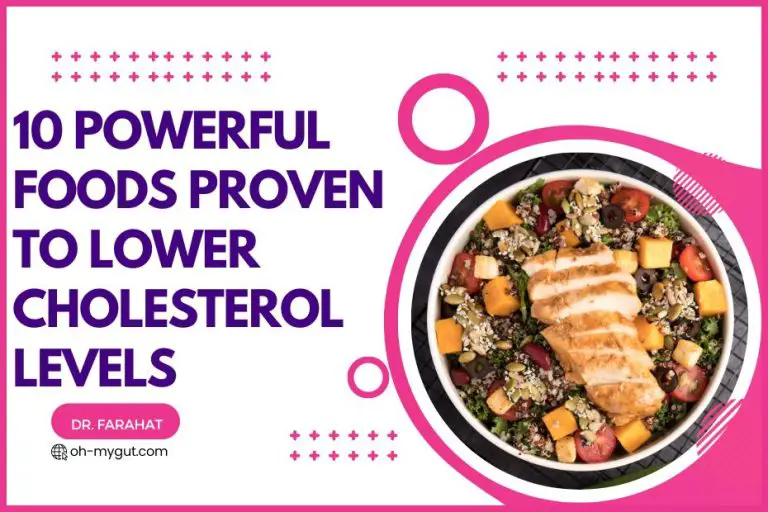9 Scientifically Proven Foods to Enhance Your Gut Health (Doctor Explains)
Our content is not intended nor recommended as a substitute for medical advice by your doctor. Use for informational purposes only.
Hello everyone! It’s Dr. Farahat. A healthy gut often starts with healthy foods. As A gastroenterologist, I’ve learned over the years that garbage foods always equals bad gut health and bad overall health.
So, I think incorporating specific foods into your diet can positively influence your gut bacteria.
Here are my TOP 9 foods that actually benefit your health (based on scientific evidence).

1. Yogurt
A systematic “American Journal of Clinical Nutrition” review found that consuming yogurt with probiotics can improve gut microbiota composition and alleviate lactose intolerance symptoms (reference). The researchers found that regular yogurt intake increased beneficial bacteria like Lactobacillus and Bifidobacterium.
Tips for Use:
- Choose the Right Yogurt Type:
- Opt for yogurts labeled with “live and active cultures” to ensure probiotic content.
- Select plain, unsweetened varieties to avoid added sugars, which can negatively impact gut health.
- Incorporate into Meals:
- Mix yogurt with whole-grain cereals, oats, or chia seeds for a fiber-rich start to your day.
- Create a yogurt parfait with layers of fresh fruits, nuts, and seeds.
- Pair yogurt with fresh fruits like berries, bananas, or sliced apples for added vitamins and prebiotic fibers.
- Use yogurt as a dip for vegetable sticks such as carrots, cucumbers, and bell peppers.
- Blend yogurt with fruits and leafy greens to create a probiotic-rich smoothie.
- Add a spoonful of flaxseeds or hemp seeds for extra fiber and omega-3 fatty acids.
- Use yogurt as a base for salad dressings or dips by mixing herbs and spices.
- Substitute sour cream or mayonnaise with yogurt in recipes for a healthier alternative.
- Choose the Right Yogurt Type:
Yogurt may not be for everyone. Here is why:
- If lactose intolerant, try lactose-free yogurt or those made from plant-based milks fortified with probiotics.
- Store yogurt properly in the refrigerator to maintain the viability of the probiotics.
- Be cautious with flavored yogurts, as they may contain high amounts of added sugars.
2. Kefir
This Interesting research in Nutrition Research Reviews explains it all. kefir consumption enhances lactose digestion and modulates gut microbiota. Kefir contains up to 30 strains of probiotics. This offers a diverse microbial profile.
Tips for Use:
- Daily Consumption:
- Start with a small amount (e.g., half a cup) to allow your body to adjust to the influx of probiotics.
- Gradually increase intake to one cup per day as tolerated.
- Variety of Forms:
- Plain Kefir:
- Drink it straight or add a splash of honey or maple syrup for natural sweetness.
- Add a pinch of cinnamon or vanilla extract for extra flavor.
- Flavored Kefir:
- Choose varieties flavored with natural fruits, but watch out for added sugars.
- Make your own flavored kefir by blending in fresh or frozen fruits.
- Plain Kefir:
- Culinary Applications:
- Smoothies:
- Use kefir as a liquid base in smoothies for an extra probiotic boost.
- Combine with ingredients like spinach, kale, or avocado for added nutrients.
- Baking:
- Substitute kefir for buttermilk or milk in recipes to add moisture and probiotics to baked goods like muffins, pancakes, or bread.
- Salad Dressings and Sauces:
- Mix kefir with herbs, lemon juice, and olive oil for creamy dressings.
- Use as a base for tzatziki sauce by adding cucumber, garlic, and dill.
- Smoothies:
- Homemade Kefir:
- Consider making your own kefir at home using kefir grains and milk for maximum freshness and probiotic content.
- Experiment with different types of milk, such as cow’s milk, goat’s milk, or non-dairy alternatives like coconut or almond milk.
- Daily Consumption:
Considerations:
- Store kefir in the refrigerator and consume by the expiration date to ensure probiotic viability.
- Those with dairy sensitivities can try water kefir made from sugar water and kefir grains.
3. Sauerkraut
Sauerkraut isn’t just a tangy topping; it’s a probiotic-rich food that can benefit your gut. Studies have shown that fermented foods like sauerkraut are loaded with lactic acid bacteria, which can enhance the diversity of your gut flora. Specifically, consuming sauerkraut can increase the abundance of beneficial bacteria like Lactobacilli (reference).
How to Include Sauerkraut in Your Diet:
Choose Raw Sauerkraut:
- Opt for raw, unpasteurized sauerkraut found in the refrigerated section. Pasteurization can kill those beneficial probiotics.
- Look for products with simple ingredients: cabbage, salt, and perhaps natural spices.
Serving Suggestions:
- As a Side Dish: Pair sauerkraut with grilled meats, fish, or tofu. It’s a classic match with sausages or bratwursts.
- In Sandwiches and Wraps: Add it to sandwiches, burgers, or wraps for a tangy crunch. Try combining it with avocado and turkey in a whole-grain wrap.
- In Salads: Mix sauerkraut into salads or grain bowls for added flavor and probiotics. Top a green salad with sauerkraut, nuts, and a vinaigrette dressing.
- In Soups and Stews: Stir sauerkraut into soups or stews near the end of cooking to retain its probiotic benefits. It’s a key ingredient in recipes like Eastern European sauerkraut soup.
Culinary Pairings:
- Combine sauerkraut with potatoes, carrots, and other root vegetables in roasted dishes.
- Top baked potatoes with sauerkraut and a dollop of Greek yogurt.
Tips:
- Start with small amounts to let your digestive system adjust.
- Be mindful of sodium content, as sauerkraut can be high in salt.
- Store it in the refrigerator and use clean utensils to avoid contamination.
4. Kimchi
Kimchi, a spicy fermented dish from Korea, offers more than just flavor—it benefits your gut health. Research has demonstrated that kimchi positively affects gut microbiota and gastrointestinal well-being. Regular consumption has been linked to reduced gut inflammation markers (reference).
Incorporating Kimchi into Your Meals:
- As a Side Dish, Serve kimchi alongside rice, noodles, or other grains. It’s a staple in Korean-style meals, along with other fermented foods.
- In Stir-Fries: Add kimchi to vegetable or protein stir-fries for extra flavor and probiotics. It pairs well with tofu, mushrooms, and green onions.
- In Soups: Create kimchi stew by simmering kimchi with broth, tofu, and spices. You can also add it to noodle soups like ramen for a spicy kick.
- As a Topping: Use kimchi as a topping for tacos, burgers, hot dogs, or pizzas for a fusion twist. It adds an unexpected flavor to quesadillas or grilled cheese sandwiches.
Cooking Tips:
- Add kimchi towards the end of cooking to preserve its probiotic content.
- Use kimchi juice as a marinade for meats or vegetables.
- Mix kimchi into scrambled eggs or omelets for a spicy twist.
Considerations:
- Kimchi can be spicy; if heat-sensitive, start with small amounts.
- Check store-bought varieties for added sugars or preservatives.
- Store kimchi properly in the refrigerator to maintain its probiotic benefits.
5. Garlic
Garlic isn’t just a flavorful addition to meals; it also supports gut health. Studies have found that garlic contains prebiotic fibers that stimulate the growth of beneficial gut bacteria. Specifically, it increases levels of Bifidobacteria while suppressing harmful bacteria (reference).
How to Use Garlic:
Preparation Techniques:
- Crush or Chop: Crushing or chopping garlic and letting it sit for 10 minutes before cooking enhances allicin formation, which has health benefits.
- Raw Consumption: Add garlic to dressings, salsas, or dips for maximum prebiotic effects. Mix minced garlic into hummus or guacamole.
Cooking Applications:
- Roasting: Roast whole garlic bulbs to mellow the flavor. Use as a spread on whole-grain bread or add to mashed potatoes and soups.
- Sautéing: Sauté garlic with vegetables, lean proteins, or grains. Infuse olive oil with garlic by gently heating it for dressings or drizzling over dishes.
- Soups and Stews: Add minced garlic to soups, stews, and broths for depth of flavor. Combining with ginger and turmeric creates an immune-boosting broth.
Flavor Enhancer:
- Use garlic to flavor oils or vinegar for dressings.
- Combine with herbs like basil, oregano, or rosemary to reduce the need for added salt.
- Include in spice blends or rubs for meats and vegetables.
Considerations:
- Excessive raw garlic may cause digestive discomfort in some individuals.
- Store garlic in a cool, dry place to prevent sprouting and spoilage.
- Be mindful of garlic breath; chewing parsley or mint can help freshen breath after consumption.
6. Onions
Onions are more than a kitchen staple; they’re beneficial for gut health. Research indicates that onions are high in inulin and fructooligosaccharides, which act as prebiotics. These compounds promote the growth of beneficial bacteria and improve gut health (reference).
Ways to Enjoy Onions:
Variety of Forms:
- Use different types of onions—red, white, yellow, shallots, green onions—for flavor variety and nutritional benefits.
- Incorporate leeks and chives, also part of the allium family.
Culinary Uses:
- Raw: Add sliced onions to salads, sandwiches, and salsas. Red onions offer a milder, sweeter flavor when raw.
- Caramelized: Slow-cook onions to caramelize them. Use in dishes like French onion soup, pizzas, or as a topping for meats.
- Grilled or Roasted: Grill onion slices or roast with other vegetables like peppers and zucchini. Skewer chunks for kebabs.
- Pickled Onions: Make quick pickled onions by soaking thinly sliced onions in vinegar, sugar, and salt. Use as a topping for tacos, salads, or burgers.
Cooking Tips:
- Cooking onions can reduce their sharpness, making them easier to digest.
- Sauté onions as a flavorful base for soups, stews, and sauces.
Considerations:
- Some individuals may experience digestive discomfort; adjust intake accordingly.
- Store onions in a well-ventilated, cool, dry place away from potatoes to prevent spoilage.
- Avoid feeding onions to pets, as they can be toxic to animals.
7. Asparagus
Asparagus isn’t just delicious; it’s also good for your gut. Studies have shown that asparagus contains inulin, a prebiotic fiber that fosters a healthy gut microbiome. This leads to enhanced growth of Bifidobacteria and improved digestion (reference).
How to Enjoy Asparagus:
Cooking Methods:
- Steaming: Steam asparagus to retain nutrients and natural flavor. Drizzle with olive oil and lemon juice after steaming.
- Grilling: Brush with olive oil and grill for a smoky taste. Sprinkle with garlic powder or Parmesan cheese.
- Roasting: Roast with garlic, herbs, and a pinch of sea salt for a crispy texture. Add cherry tomatoes or bell peppers for color.
Serving Suggestions:
- Salads: Add steamed or roasted asparagus to salads with leafy greens and vinaigrette dressing. Combine with quinoa, feta cheese, and olives.
- Egg Dishes: Include in omelets, frittatas, or quiches with other vegetables. Top avocado toast with grilled asparagus and a poached egg.
- Pasta and Grain Bowls: Mix into pasta dishes with whole-grain pasta, olive oil, and fresh herbs. Add to grain bowls with brown rice or farro.
Flavor Enhancements:
- Drizzle with balsamic glaze or sprinkle with toasted nuts or seeds.
- Serve with hollandaise sauce or herb butter for a classic pairing.
Considerations:
- Use fresh asparagus when possible; look for firm stalks with tight tips.
- Store in the refrigerator with stalks wrapped in a damp paper towel.
- Consume within a few days for the best quality.
8. Bananas
Bananas are not only convenient snacks but also support gut health. Studies have found that bananas are rich in resistant starch and prebiotic fibers that nourish gut bacteria. Regular consumption increases beneficial bacteria and reduces bloating (reference).
Incorporating Bananas into Your Diet:
Ripeness Matters:
- Slightly green bananas contain more resistant starch, beneficial for gut health.
- Riper bananas are higher in simple sugars but still offer prebiotic fibers.
Easy Snack:
- Eat bananas on their own as a portable snack.
- Spread nut butter on slices for added protein and healthy fats.
- Freeze banana slices for a refreshing treat.
Breakfast Options:
- Oatmeal Topping: Slice bananas over oatmeal or yogurt. Sprinkle with cinnamon or chia seeds.
- Smoothies: Blend frozen bananas into smoothies for natural sweetness and a creamy texture.
- Pancakes and Waffles: Mash bananas into batter for natural sweetness. Top pancakes with sliced bananas and a drizzle of honey.
Baking:
- Use mashed bananas as a natural sweetener in baked goods like muffins, breads, or cookies.
- Make banana energy balls by mixing mashed bananas with oats and nuts.
Desserts:
- Create banana “nice cream” by blending frozen bananas until smooth.
- Grill bananas with a sprinkle of cinnamon for a healthy dessert.
Considerations:
- If monitoring sugar intake, be mindful of portion sizes.
- Store bananas at room temperature; refrigerate to slow ripening.
- Prevent browning by coating cut surfaces with lemon juice.
9. Whole Grains
Whole grains like oats and barley aren’t just filling; they boost gut health. A randomized controlled trial showed that consuming whole grains improves gut microbiota diversity. Participants had increased levels of beneficial bacteria and an improved immune response (reference).
How to Incorporate Whole Grains:
Choosing Whole Grains:
- Look for labels stating “100% whole grain” or “whole [grain name].”
- Examples include brown rice, quinoa, whole-wheat pasta, barley, oats, and bulgur.
- Experiment with grains like millet, amaranth, or teff for variety.
Breakfast Ideas:
- Oatmeal: Start with oatmeal topped with fruits, nuts, and cinnamon. Try overnight oats by soaking oats in milk or yogurt with chia seeds.
- Whole-Grain Cereals: Choose cereals high in fiber and low in added sugars. Make homemade granola with oats, nuts, seeds, and honey.
Meal Incorporation:
- Salads: Add cooked quinoa or barley to salads for extra fiber. Mix with roasted vegetables and vinaigrette.
- Side Dishes: Serve brown rice or whole-wheat couscous instead of refined grains. Prepare pilafs with wild rice, nuts, and dried fruits.
- Main Dishes: Use whole-grain pasta in recipes with tomato or pesto sauce. Make stuffed peppers with grains and vegetables.
Baking with Whole Grains:
- Substitute half or all white flour with whole-wheat flour in baking.
- Experiment with flours like oat, spelled, or rye in pancakes, muffins, and bread.
Snacks:
- Choose whole-grain crackers or air-popped popcorn.
- Make homemade granola bars using oats and other grains.
- Try rice cakes topped with avocado, hummus, or nut butter.
Considerations:
- Increase intake gradually to allow your digestive system to adjust.
- Drink plenty of water to aid fiber digestion.
- Read labels carefully; some products labeled “multi-grain” or “wheat” may not be whole grain.
Additional Tips for Enhancing Gut Health
Improving gut health isn’t just about specific foods; it’s also about overall lifestyle choices.
- Diversify Your Diet: Eating a wide variety of foods promotes a diverse microbiome, beneficial for gut health. Include a rainbow of fruits and vegetables for different types of fiber and nutrients.
- Stay Hydrated: Water aids digestion and helps maintain the mucosal lining of the intestines. Aim for at least 8 cups of water per day.
- Limit Processed Foods and Sugars: High intake of processed foods and sugars can negatively impact gut bacteria balance. Choose whole, unprocessed foods when possible.
- Regular Physical Activity: Exercise positively influences gut microbiota composition. Aim for at least 150 minutes of moderate-intensity exercise per week.
- Manage Stress: Chronic stress can alter gut bacteria and affect gut health. Practice stress-reducing activities like meditation, yoga, or deep breathing.
- Mindful Eating: Chew food thoroughly and eat slowly to aid digestion. Pay attention to hunger and fullness cues.
- Adequate Sleep: Poor sleep negatively affects gut health. Aim for 7-9 hours of quality sleep per night.
- Limit Antibiotic Use: Use antibiotics only when necessary, as they can disrupt gut microbiota. Discuss alternatives with your healthcare provider.
- Consult a Professional: If you have digestive issues, consult a healthcare provider or registered dietitian. Consider probiotics or prebiotics under professional guidance.
Conclusion
By adding these scientifically supported foods to your daily diet and following the tips provided, you can enhance your gut health significantly. A balanced gut microbiome not only improves digestion but also supports your immune system and overall well-being. Introduce new foods gradually and pay attention to how your body responds. If you have any health conditions or concerns, consult a healthcare professional for personalized advice.
- Evidence-based
- Written by a doctor.

Related Posts:
- 10 Powerful Foods Proven to Lower Cholesterol…
- Worst Foods To Avoid If Prediabetic (Doctor Explains)
- 7 Foods to Avoid With High Cholesterol (Doctor Explains)
- 6 Worst Foods To Avoid With Hypertension (Doctor Explains)
- 11 Evidence-Based Foods To Lower Cholesterol Levels…
- 10 Takeaway Foods to Eat with Gallstones (& What…










